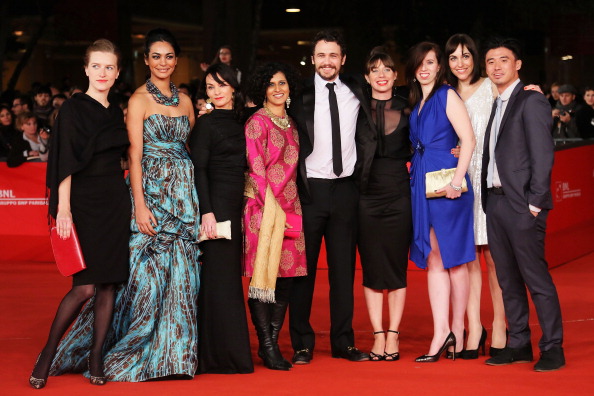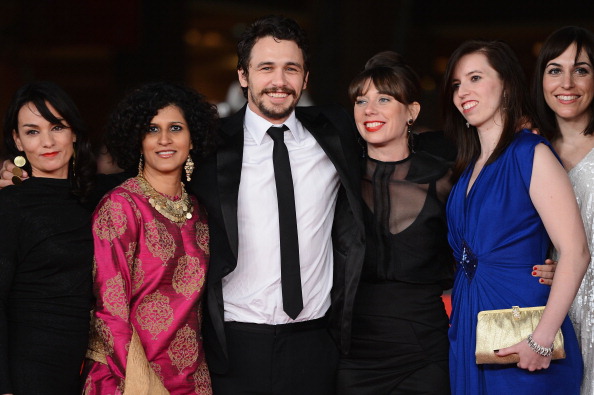For our second semester, the main project is the Adaptation – a seven-minute narrative film. The assigned camera for the Adaptation was the quite excellent Panasonic DVX-100, a standard def camera. But this year is also the year of the HDSLR. They are affordable, they are easy to use and students are willing to experiment and take risks. Voilà, the perfect storm.
Out of the class of 36, 18 of us shot on an HDSLR ((The rest shot on a combination of the DVX and the EX-1)). Most on a Canon and one person on a Nikon. That’s an incredible number of people to use a school unsupported format and figure out everything ourselves (especially all the gnarly post-production issues).
I shot on the Canon 5D, the magnificent full-frame camera in the Canon lineup. Fortunately Canon released the 24p upgrade for the 5D two weeks before my shoot so we were able to shoot the film on 24p instead of 30p. I also wanted as much latitude as possible in post for color correcting and so we shot with a custom gamma curve to flatten the image.
First up was figuring out the lenses needed and I decided that in addition to my delightful 50m F1.4 Canon lens, I would rent the F2 Zeiss Primes in 35, 50 and 100 focal length. I also rented the Canon F2 L 200m lens – a giant lens that delivered incredibly well. We ended up using only the Canon 50m for the outdoor night shots as it was the only one that would open up enough and it is amazing that we shot at night with only available light on the 5D – a huge positive of the full frame sensor. The rest of the lenses, we used for the internal locations. We ended up being barely able to squeeze the 200m into the apartment since the minimum focal length was 8 feet, but it delivered an exceptional closeup, single shot of the actors that we were looking for with an really, really shallow DOF.
I was incredibly lucky that my buddy Mitch agreed to gaff this film ((Not only did Mitch gaff this film, he also helped me check out equipment, came with me to equipment rental houses, moved stuff and basically helped me in every way during the shoot.)). He flew in from LA a few days early and while the rest of the crew was busy with the previous production (we shoot in rotation), he and I did some tests to figure out where to shoot the night shots. We also examined all the equipment (but overlooked some rig testing that came back to bite us in the rear later).
In terms of equipment, I rented an external monitor. A downside with the 5D (that the 7D and 550D don’t seem to have) is that when you hit record on the 5D, the monitor drops to 480p which makes it difficult to focus. Annoying, but once you adjust to this problem, it is still worth having the monitor.
I also rented a Redrock rig, but it failed us at a key moment when we needed to follow focus because the ring wasn’t the right size and the screw got in the way. My bad for not enough testing ahead of time. The AC did a great job of pulling focus manually though and the shot was still usable.
This is one of the big downsides of the camera – it is basically a still camera and we are making it work as a film camera. Pulling focus is tough because the lenses are small and still lenses go around past infinity. That means, when you mark your focus marks, if you go past infinity, all of them are useless for the next take. This is especially true of Canon lenses. The Zeiss lenses have the added benefit of not rotating past infinity and therefore being better for film. A lot of shots, especially as you pull focus with a moving object could be out of focus in parts. If you watched the House season finale, you will see that even they had this problem (although they did a lot of excellent editing to get around some of the out of focus shots).
Lighting was contained both because of the style of the film and also because of the camera. A large chunk of shots were around a table and we used a china ball for that with an inky adding edge and a practical in the background for aesthetics and lighting. There were definitely shots that were complicated with windows all around the DP and Gaffer did their thing figuring out where to hide things and people so as to get the shot. As I mentioned before, for the nighttime exteriors, we were able to just go with available lighting.
In terms of Audio, the sound on all versions of the HDSLRs are crappy. You have to do dual system – we used the FP-33 mixer going into the 702T recorder. We also recorded camera sound. Recording camera sound is really important for two reasons. One, you can get going with a basic edit with the horrendous sound as a scratch track. Two, much more importantly, if you have it, you can use Plural Eyes to sync up your sound. It’s not perfect, but it’s pretty close.
One of the problems I encountered while editing is that in clips that were longer than seven minutes or so (ah, the joy of video where we could keep rolling), the sound started to fall out of sync. What you need to do is adjust the speed of the clip to be 100.06 in FCP and then it settles down and comes back into sync.
Staying in the post-production world, there’s one other consideration that’s a biggie and that’s how to convert the files and into what format ((Our class banded together to help each other through post. The first person who shot on the 7D, Zach, did a ton of research (and found Plural Eyes!) and shared it with the class. As people discovered things, they shared it and the whole group used the information)). Post options abound but I went with a converter called NeoScene because it gave me the extra color correction latitude I wanted. Then I had to figure out which codec to use – the choice for me was between Prores and CineForm, the NeoScene codec and I chose Prores because CF would constrain me to use the NeoScene post processing tools versus Color which is part of the Final Cut Studio package. The difference between Prores Standard and HQ doesn’t seem significant in any real way except space consumed on the hard drive, so Standard it was. All of this took some figuring out. Conversion takes a while, but all in all, I’d rather several hours of computer processing time than logging and capturing tape any day!
I ended up color correcting since I shot flat and bringing back the richness that I’d flattened out. It took a few hours in Color with an expert who knew what he was doing to make sure the skin tones looked right and the colors all looked like I wanted them. The flexibility in post is incredible if you flatten out the image a bit while you shoot.
While a lot of things change with the HDSLRs, some things don’t. The primary thing is that you still need a great crew (and a full crew) to make the shoot happen. My DP, Eunice, owns the 5D and had shot her documentary on it. She was super-familiar with it and that was really critical. Omar, the AC, is one of the most dedicated people to have on a set. He did all the focus pulling manually, noted down all lenses and distances for each shot so that if we had to replicate it or check anything, it was all right there. He was also responsible for the downloading and transferring of the footage which he was extremely diligent about. It’s a ton of work to do and he did it exceptionally. Mitch was the gaffer and, having DPed on the 5D and gaffed a ton of films, he was indispensable. The audio was run by Bella and despite the difficult conditions of a street-facing Brooklyn apartment near the park, she did a wonderful job of getting great dialog and being particular about the crew paying heed to the sound needs ((something that is often overlooked on small, indie productions)). Ed and Alexis both boom op-ed during the shoot (sometimes lying down to get out of the way) and Alexis played the extra role of being a wonderful production designer and a script supervisor who made a complicated card scene flow easily. And my producer/AD Ryan was awesome in allowing me the time I needed but also making me cut shots when required. Ryan ran the set very smoothly and ensured I didn’t have to think about anything else when I was directing. Ravi was the PA and he had contacted me through this blog – he came to NYC on his own and paid for his own stay and worked his ass off on set. He earned the respect of the crew and learned a ton in the process. Donald was our makeup artiste and Ruoyi was the still photographer and they both had a great attitude and were exceptional at what they did.
All of the great work the crew does is to showcase the actors – and the actors were all top-notch – not only in their craft but also in terms of their attitude on set and being flexible and accommodating.
I am so grateful to the cast and crew – the hours were really long and the shoot was tiring and every single person did more than pull their weight. I also had two sets of wonderful friends who were my executive producers. They let me shoot in their homes and were gracious and welcoming – true patrons of the art! Without each person involved, the shoot would not have come together.
I thought shooting with the HDSLR would make things easier. And it did in certain regards, but the basics of film making stay the same, the director’s role stays the same. In another post, I will talk about what I learned in this shoot – especially around shooting dialog with multiple actors, eye-line and all those other wonderful things.
That covers most of my experience of shooting and post on the HDSLRs. Feel free to ask any questions – I’ll try to answer them and Mitch, who lurks around here, will also answer your questions ((all he wants in exchange is some Sauvignon Blanc 🙂 )).
If you are thinking of buying one or shooting with one, but don’t know how they all stack up, this post by Philip Bloom is an excellent review of all the viable models out there. Enjoy.



